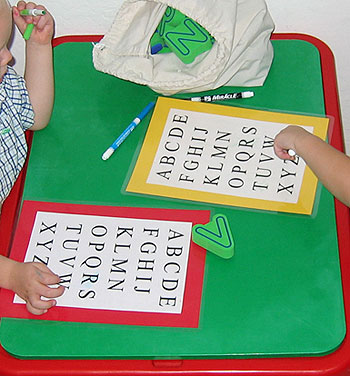A Love of Learning
Â
How to inspire curiosity, creative thinking, and joy along your child’s path to greater knowledge
Â
I remember thinking during my first year as a teacher that I had to be “teaching” all the time — that, in fact, I had to teach children how to learn. Through my preschoolers, however, I discovered that some of the best learning happens when you stop trying to teach and begin letting experiences flow naturally. The children taught me how to listen, watch, ask questions, and simply be real. They also showed me the magic of play and how much can be learned from it, whether it’s building a city with blocks, pretending to be a ballerina, or jumping like a bullfrog.
By following my students’ lead, I came to realize that to be an effective role model for learning, I had to be authentic with my own thoughts, feelings, and values. As adults, we can inspire and encourage a love of learning in our children, but we can’t really teach it. We can do far more good by creating an environment of support — both at home and at school – in which children can develop their own ideas, express feelings, take chances, make choices, share their opinions, and most of all, grow to be strong individuals.
A Life-Long Process
Very early in life children begin exploring the world with their bodies, senses, and developing skills. They intuitively know how to take the smallest observation, object, or surprise and turn it into a meaningful experience. Best of all, they are curious! Kids want to find out the “who, what, where, when, how, and why” of everything around them. As parents, we serve our children well by encouraging their inquisitive natures, because curiosity is the primary motivating factor for seeking knowledge.
Â
 Learning should be seen as a process — a series of experiences that lead to the great “ah-ha!” moments of life. Sadly, when adults participating in a research study were asked how they felt about learning in school, the majority said that many things — pressure to pass tests, anxiety about answering correctly, and concern about meeting expectations — took the joy out of learning. But they also said that they enjoyed learning when they could explore things on their own at home, outdoors in nature, and later when they went to college.
Â
Many education experts believe that self-driven explorations are in fact the key to unlocking the joy of learning. Dr. Lillian Katz, professor emerita of early childhood education at the University of Illinois, goes further, saying that all “quality learning experiences” engage children in the investigation of worthwhile topics and provide intellectually challenging tasks, which ultimately build a child’s confidence in his own intellect. She says, if we “rephrase the goals of education,” we will not only help children learn, we will help them lead more satisfying lives.
It All Begins At Home
Creating a home climate that invites investigation, creative thinking, and collaboration lays the foundation for quality learning experiences. When you provide plenty of time and space for open-ended play every day, you create opportunities for your child to really feel the joy of learning. But it’s important to remember that fostering a love of learning is not just about the materials or activities you provide, but rather your own responsive, inquisitive attitude toward learning.
Â
One of the easiest ways to deepen your child’s thinking is to have meaningful conversations about his activities. When you ask great questions and invite discussion, you help him construct his own learning. In other words, it’s not just what your child plays; it’s what you and he say, think, and feel about the play.
Â
All of this leads to an important point: You are your child’s first teacher, and your interactions with him can turn virtually any moment or place into a teachable opportunity. Being a great motivator and teacher, however, requires a balanced approach and knowing when to simply watch, listen, or jump in to help out. With that in mind, here are some ways to guide your child:
Share your own love of learning. Get excited and wonder! Notice the butterfly in the park, the ants congregating on a crumb on the sidewalk, and wonder about the formations in the cloud. Talk about what you notice and invite your child to share his observations.
Â
Show how you can learn from the simplest events and small mistakes. The excitement you show when you discover how to balance a block, for example, demonstrates the supreme joy of learning. The willingness to show your child that you can make mistakes — and ask for help in solving the resulting problem — can make children feel helpful and valued. They also learn that making mistakes is not a “bad thing”; it’s an important part of learning.
Â
Offer your support and acceptance. Encourage and accept your child’s ideas. When you set a tone that welcomes your child’s original ideas and create a safe and secure atmosphere, he can feel free to express his ideas without fear of being wrong, or of not being taken seriously. You build on children’s strengths and abilities so that your child sees herself as a successful learner.
Be inquisitive and seek answers. Not sure about a word or a fact? Demonstrate how to look things up in a dictionary or on the Internet. Look things up together.
Â
Give your child choices. Learning is about making choices. If you show your child how you go about making choices he learns that he doesn’t always have to have all the answers. Give your child appropriate choices (that you consider acceptable). Choice helps kids feel good their thinking abilities, which is essential to motivating them to learn.
What Teachers Want You to Know
All teachers have their own unique approach to teaching, but all of them want the children they teach to come to school happy, healthy, and ready to learn. Children need to have their basic needs met before they can even begin to think about learning. That means good nutrition (particularly a healthy breakfast and snack), plenty of exercise (some time at the park after school), and lots of love (make time for hugs and conversations)!
A feeling of security, which comes from your child knowing what to expect and what is expected of him — both at home and at school — is essential. Regular routines, such as scheduled bedtime, snacktime, or reading time, help your child gain a sense of understanding of his day. Clear rules help him know what is expected, and if he has a hand in creating those rules, he’ll be more inclined to follow them. Once your child’s social and emotional needs are met, he can begin to explore learning skills and content.
Â
Another big message from teachers is to try to take the pressure off of learning specific skills and facts, such as the ABCs and 123s, and instead focus on your child’s disposition toward learning. It’s very difficult to teach children skills if they are not interested in learning. A child needs to be excited and happy about acquiring knowledge before he learns how to read, write, or count.
How to Support What Your Child Learns in School
One the first things you can do to support your child’s learning at home is to communicate with your child’s teacher to find out what’s going on in the classroom. What is being studied? What stories are being shared? What are your child’s favorite activities in class? Then give him the space and time to explore and play. If you strictly control how your child spends his time, you limit his chances to make decisions and experiment with new materials and ideas.
Â
 By knowing what interests your child and how he learns best, you will be able to help him build skills in the context of his strengths. For example, rather than ask your child to “work on his letters” when he would rather be playing with his cars, invite him to draw pictures, make signs for his car and roads, license plates, car names, or anything that involves letters, words, and cars!
Â
Many activity ideas that your child’s teacher uses in the classroom can easily be borrowed and adapted for your home. Taking a cue from your child’s teacher and your child’s own interests will help you reinforce what he is learning at school. Here are some easy ideas:
Â
Foster independence. Set up your home environment so that your child can act independently. Use picture/word cues and signs on toy storage containers and bookshelves; place books and often-used materials low so that he can access them; use clear containers for self-service activities, such as writing and drawing, on low shelves.
Â
Provide a diverse range of materials. Offer blocks, puzzles, plastic animals or people figures, old clothes for dress-up, art supplies, or recycled items (such as egg cartons, shoe boxes, paper towel tubes) that your child can explore independently and artistically. Introduce new materials periodically to keep him inspired. Even one new thing can challenge children to think of new ways to play.
Â
Read together often. A recent study by the Yankelovich Monitor has shown that when parents love reading and actively help their children with book selection, children are more likely to be high-frequency readers (meaning, they will read for pleasure). Set aside time to read together every day and visit the library often.
Â
Pay attention to your child’s surroundings. Aesthetics of color, beauty, and nature have a strong, positive impact on children’s behavior. At home, think about displaying something from nature (a plant, flowers, shells, rocks, a fish bowl) and an item of art (a beautiful picture, photo, sculpture, quilt). Try to choose colors that are calming. Interestingly, some classrooms avoid over-use of primary colors because they can be too intense and distracting.
Â
Take a field trip together that relates to your child’s studies or interests. If your child’s class is studying shapes, go for a walk looking for shapes around the house, in the grocery store, or at the park. If your child loves snails and insects, visit a local garden and go on a bug hunt.
Â
 With the right attitude and encouragement from you, your child is sure to develop a love of learning quite naturally. We each see and explore the world in our own way. When our children feel comfortable asking questions, confident in their ability to problem-solve, and valued when they share their ideas, learning and interacting with the world becomes a successful, joyful experience that lasts a lifetime.









